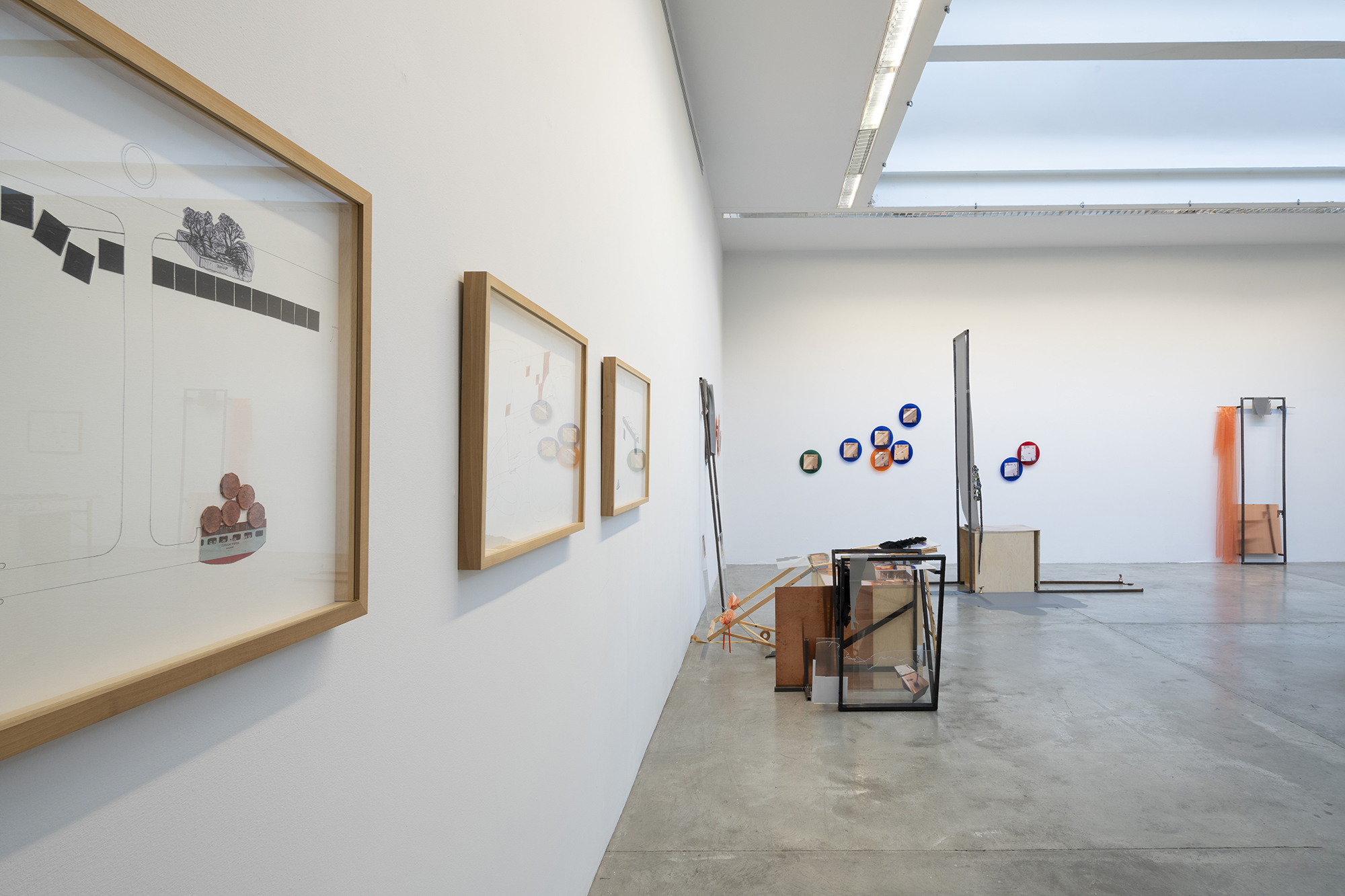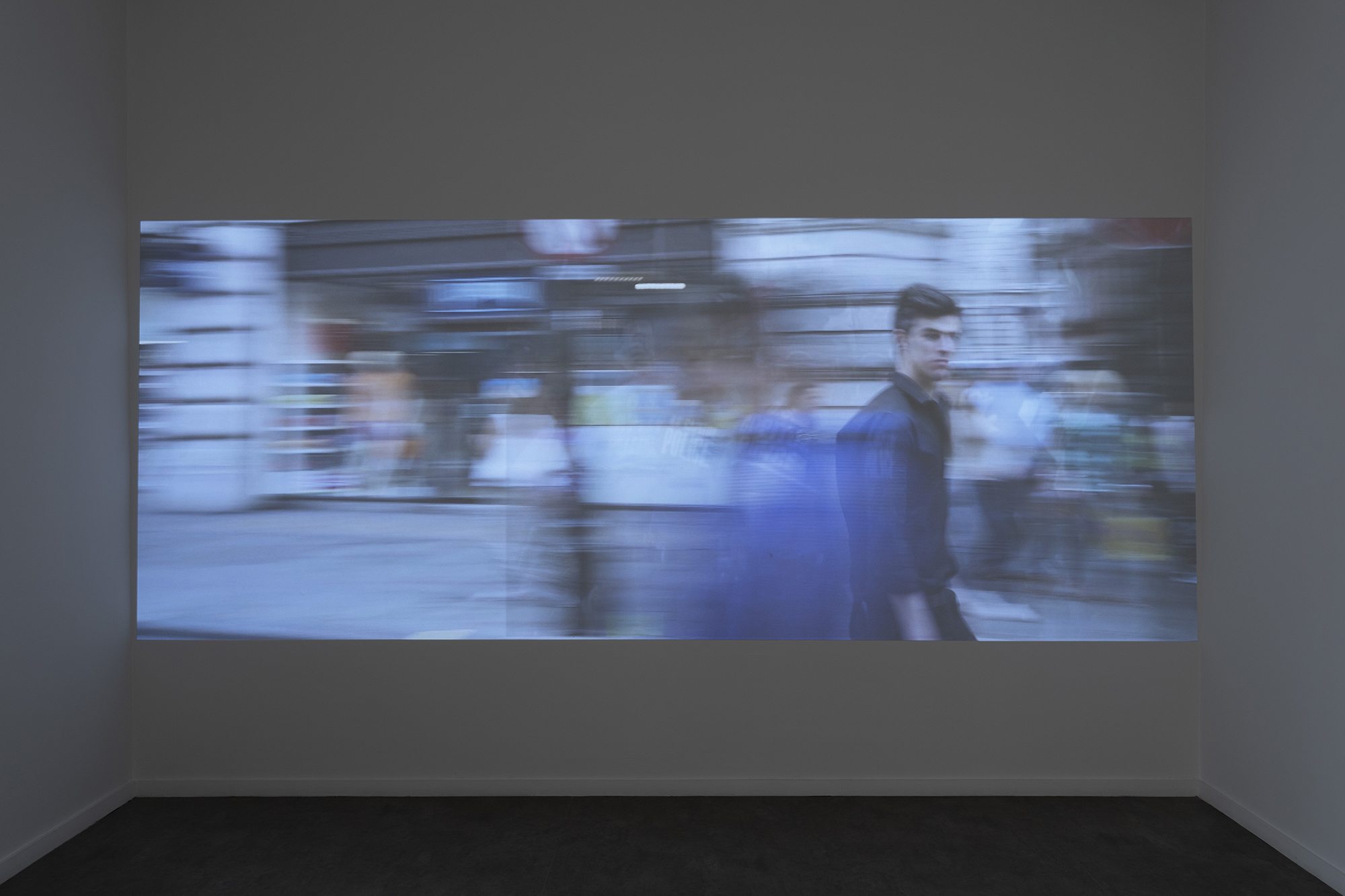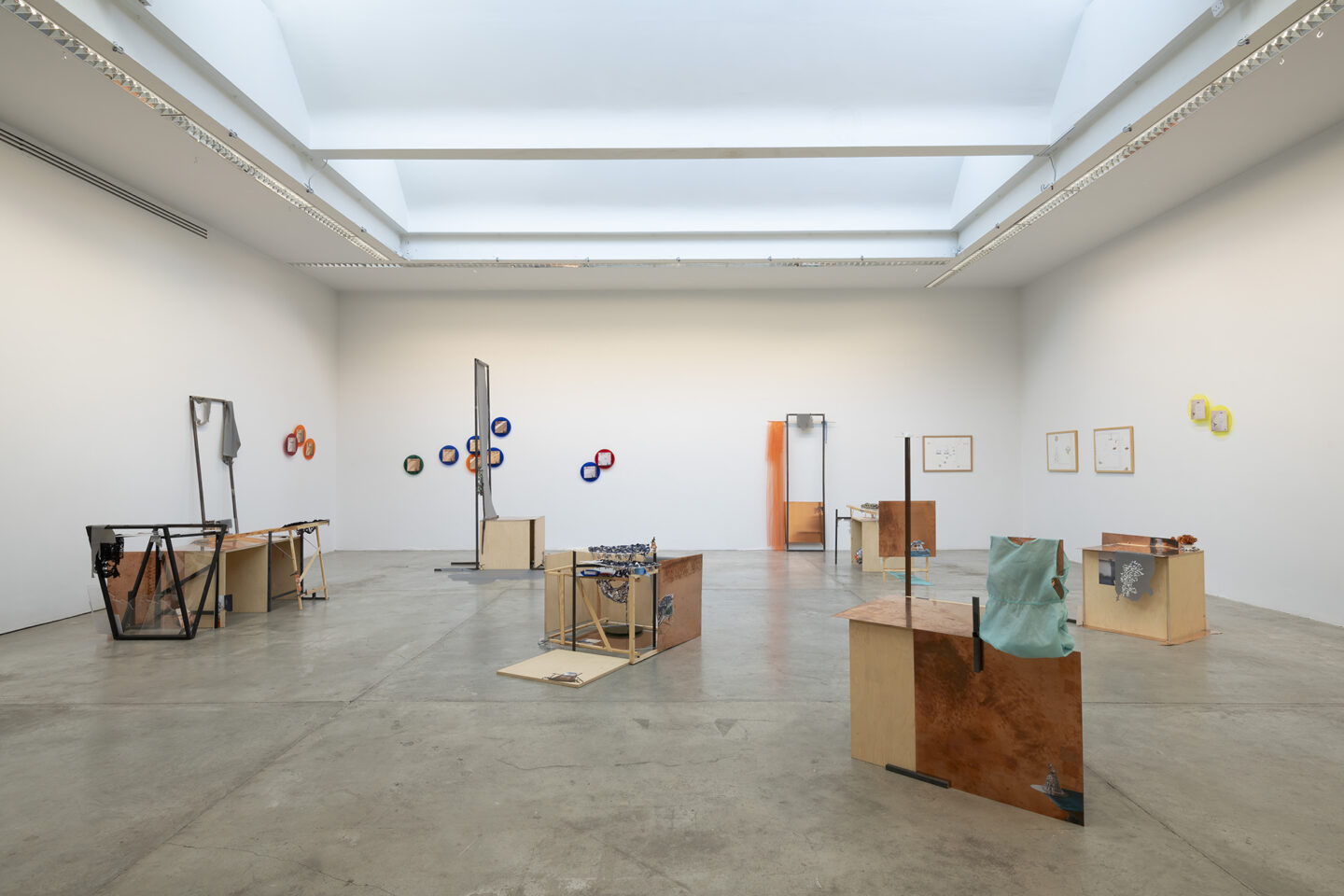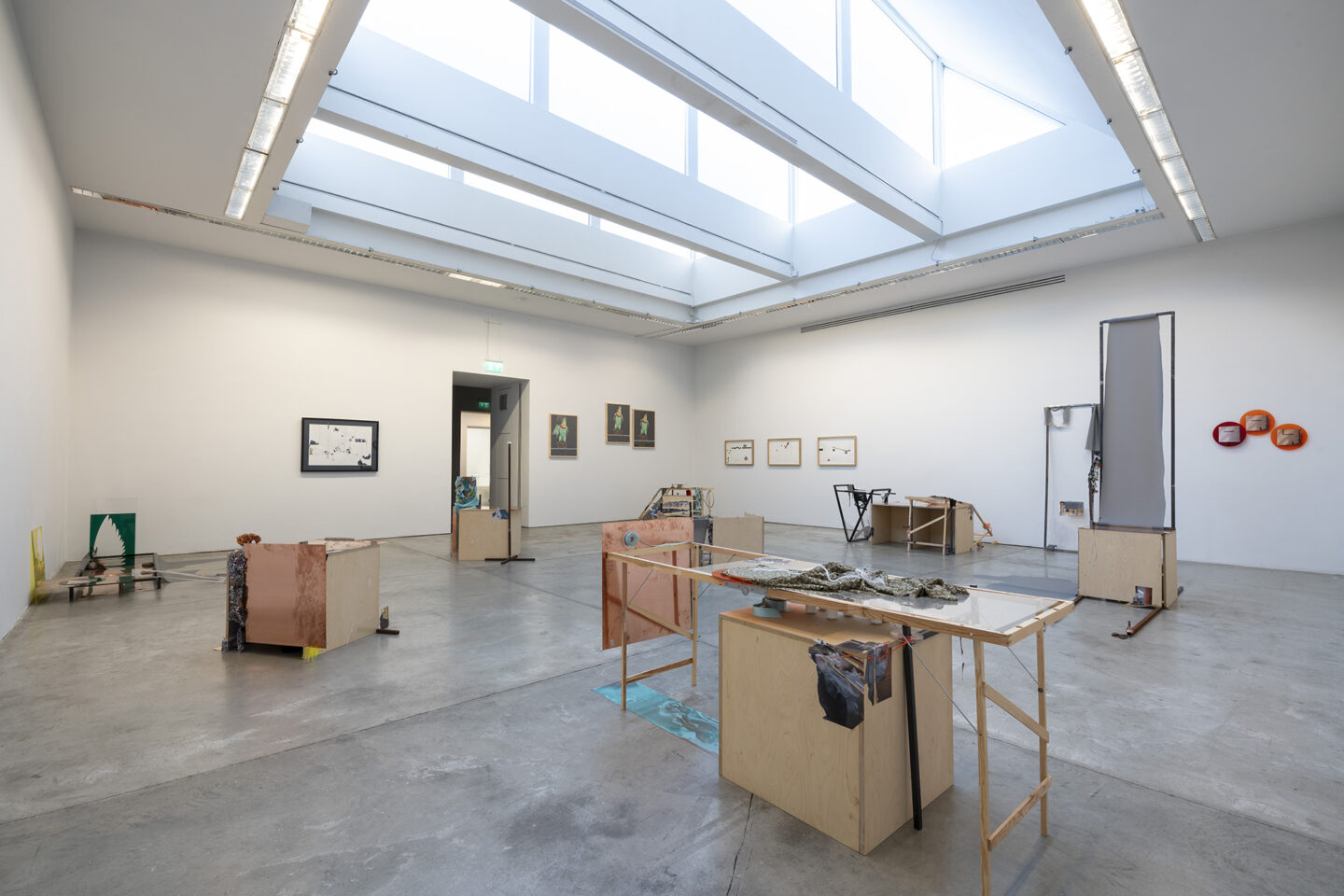Cosmus
February 15th - April 7th 2024
Limerick City Gallery of Art, Ireland
All photo credits (unless otherwise stated): Brigid McLeer, LCGA & Roland Pashhoff

Cosmus (installation view LCGA) Photo: Brigid McLeer
COSMUS is a solo exhibition of selected works from the last fifteen years, alongside a new sculptural installation of the same title, currently showing at Limerick City Gallery of Art, Ireland.
Spread across the five interconnecting spaces of LCGA’s ground floor, in addition to the installation of new work Cosmus, the exhibition includes recent commission Collateral, made for the British Textile Biennial 2021, shown for the first time alongside its sister work and precedent N scale.

N scale: installation view LCGA

Collateral: installation view LCGA
In addition the exhibition includes photographic, video and text based work In the House of Democracy; video and drawing work Adroit, a Gauche, a Gag: Three Tales after Gustave Flaubert; single screen videos The Regent’s Street and The Road (after McCarthy) and a selection of collages.
Installed throughout all the lower floor temporary exhibition galleries at Limerick City Gallery of Art, Cosmus is both a collection of works and a series of interconnecting experiences. Music and sound resonate across the different spaces and each separate work gathers up and reorientates the emotional and critical attention mobilised by another. Scales shift radically, motifs and materials cross-pollinate, but each work still is, and is in, its own place.

Cosmus (installation view LCGA)
The central gallery spaces primarily host a selection of works in which darkness incurs upon the potential for democratic life, and light, to resist the increasingly prevalent forces of autocracy and totalitarianism that pervade our world. The installation In The House of Democracy and single-screen video work The Regent’s Street both focus on the American ‘democratic’ project/promise, by drawing on resonances from history; Belcamp House, an 18th century Irish mansion designed by James Hoban architect of the White House, and Paul Fusco’s 1968 photographs of the Robert Kennedy funeral train, among others. At LCGA the derelict oval room of Belcamp House is presented in a set of almost lightless, matt photographs printed on photo rag paper and mounted onto aluminium. Two of these, that show either end of the bricked up oval room, hang in two oval arcs of black ribbon, facing each other across the interconnecting spaces of the gallery. Between them a video shot inside the oval room animates a searching in the dust and rubble for the iconic features of this proto-democratic space.

In The House of Democracy: Installation view: Digital photograph and satin ribbons. Photo printed on Photo Rag paper, mounted on aluminium.

In The House of Democracy: Installation view: Digital photograph, satin ribbons and Video. Photo printed on Photo Rag paper, mounted on aluminium.

In The House of Democracy: Video still.

In The House of Democracy: Video still.

In The House of Democracy: Digital photograph. Printed on Photo Rag paper, mounted on aluminium. One of two.

In The House of Democracy: Digital photograph. Printed on Photo Rag paper, mounted on aluminium.
The Regent’s Street, in this showing, brings the people at the edge of the train tracks in 1968 mourning the assassination of Senator Kennedy, into a larger than life size projection, where they are collaged with figures from mourners at Courbet’s revolutionary 1850 painting Burial at Ornans, and ordinary, everyday shoppers on London’s Regent Street on a sunny Sunday in July 2017. Collapsed into the synchronous time of political appearance, the figures of this video work look out to us, to now, with a call for both connection and accountability. Ghostly, but still loaded with imperative, they are reminders from the past that the future is still at stake.

The Regent's Street: video still (installation view LCGA)

The Regent's Street: video still (installation view LCGA)
To underline the present turning point that we are at between these histories and an uncertain future, video piece The Road (After McCarthy) is shown alongside this installation. Taking all of the instances of the words ‘dark’ and ‘okay’ from Cormac McCarthy’s dystopian novel The Road, the video simply plays them out, alternating between declensions of dark, darkness, the dark, darkening etc. and Okay?, okay, it’ll be okay, is it okay? etc. The resulting video text work is iterative of the emotional experience of this turning point, of its choices and implications.
The oldest work in the exhibition, from 2009, is the video piece and series of pastel drawings Adroit, a gauche, a gag: Three Tales after Gustave Flaubert (2009). Starting in the central hub of gallery spaces, amongst the blackness and darkness of the previous works, it figures an entirely alternative narrative, in which a human figure and the bright green parakeet that it is trying to draw, are entangled and interchanged. Questions about where reality lies and who gets to speak are teased out in this absurd and slightly disturbing work, in its video and its trail of green parakeet drawings that thread through from the central gallery space all the way into the newest and most modernist of LCGA’s galleries.

Adroit, a gauche, a gag: Three Tales after Gustave Flaubert. Video and drawings. (Installation view LCGA)

Adroit, a gauche, a gag: Three Tales after Gustave Flaubert. Drawings. (Installation view LCGA)

Adroit, a gauche, a gag: Three Tales after Gustave Flaubert. Drawings. (Installation view LCGA)
The newest work, Cosmus has been made specifically to respond to the South Gallery at LCGA. The neutrality and shape of this eminently ‘white box’ gallery space has become a determining form for perhaps the most dynamic play of interacting elements in the artist’s work to date. Inspired by the enmeshment of female figures, textiles and furniture in the late 19th century paintings of Edouard Vuillard, Cosmus is a universe of things set in motion with each other, made predominantly from materials stored and left over from the artist’s previous projects. In dialogue with its own memory, and memory of the world in its bits and scraps, it is more than mere recycling; a celebration of the provisional and of carefulness perhaps, and a deep investment in the possibility of renewal.


Cosmus (installation view LCGA)






Cosmus (installation view LCGA)

Cosmus (installation view LCGA)

Cosmus (installation view LCGA)

Cosmus (installation view LCGA)

Cosmus (installation view LCGA)




